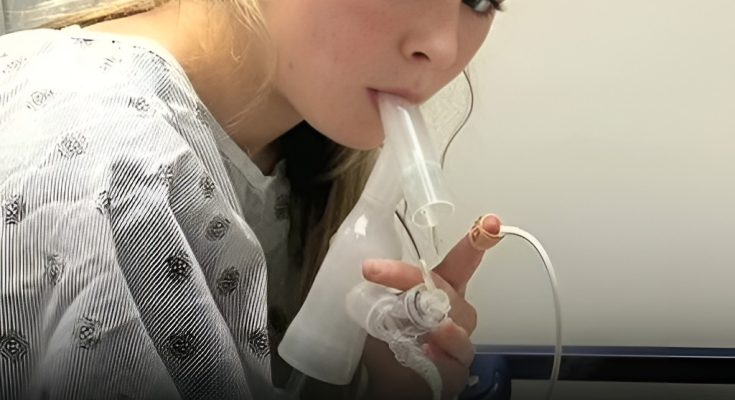A Nevada teenager’s diagnosis with a rare pulmonary condition has ignited fresh concerns about vaping safety. Seventeen-year-old Brianne Cullen, an active cheerleader, developed bronchiolitis obliterans, commonly known as “popcorn lung,” after vaping daily for three years.
A Cheerleader’s Health Crisis
Brianne began vaping at 14 to help with anxiety when returning to school after COVID lockdowns. She used a disposable vape every day without realizing the damage occurring inside her lungs. Her mother, Christie Martin, recalls the frightening moment when everything changed. “She called me all of a sudden and said she couldn’t catch her breath. She kept saying ‘I can’t breathe,’ it was the scariest thing.”
After a rushed trip to the emergency room, diagnostic tests revealed the alarming truth: bronchiolitis obliterans. This uncommon condition inflicts permanent damage to the smallest airways in the lungs. “I didn’t expect the news she gave me, that it’s popcorn lung that’s permanent and children are dying from it,” Christie shared. The condition differs significantly from smoking-related illnesses. “Smoking takes years to show its effect and your lungs can heal from it, but popcorn lung is irreversible.”
Understanding Popcorn Lung
The name “popcorn lung” originated from workers in microwave popcorn factories who developed this condition after inhaling diacetyl, a chemical compound used for buttery flavoring. When regularly breathed in, this substance damages the bronchioles, the smallest airways in the lungs. These tiny air passages play a key role in breathing. Inside our lungs is a complex network of tubes that branch out like a tree, becoming smaller as they extend. They eventually end in microscopic air sacs called alveoli where oxygen enters the bloodstream. When chemicals inflame and scar the bronchioles, they narrow, making breathing difficult.
Symptoms typically appear gradually, often showing up between two weeks and two months after exposure to harmful chemicals. People with popcorn lung commonly experience a stubborn dry cough and shortness of breath, especially during physical activity. Other signs include wheezing, fatigue, and sometimes fever or night sweats.
The Vaping Connection
Research has identified troubling links between vaping and respiratory issues, including conditions like popcorn lung. The UK banned diacetyl in e-cigarette liquids in 2016 under EU regulations, yet the ingredient remains in products sold in the United States. Health experts also worry about acetaldehyde, another chemical in some e-cigarettes that can harm the lungs. The growing popularity of vaping among young people alarms medical professionals. Recent statistics reveal that one in four children has tried vaping devices, and one in ten uses them regularly. For teens aged 16-17, usage climbs to one in six, numbers that worry doctors and parents alike.
Early Detection Makes a Difference
Brianne’s case demonstrates the importance of early diagnosis. “They told me she should be able to make a full recovery because we caught it so early, but it can also cause problems like cancer in the future,” her mother explained. Doctors prescribed an inhaler to help Brianne breathe better. However, treatment options for popcorn lung are limited beyond stopping vaping exposure. Unlike some lung conditions, popcorn lung creates permanent changes to the respiratory system. “We don’t know the status of her lungs now,” Christie admitted. “We still don’t know if there will be long-term effects.”
Medical professionals treat popcorn lung by managing symptoms while focusing on preventing the condition from worsening. Treatment approaches include avoiding harmful chemicals completely, prescribing anti-inflammatory medications, using drugs to prevent additional damage, and providing breathing medications to reduce coughing. In severe cases, supplemental oxygen supports breathing. For cases that continue to worsen despite treatment, a lung transplant may become necessary, though doctors try to avoid this through early detection and intervention.
A Mother’s Warning
Christie has become an advocate for vaping awareness. “I would urge parents to spread awareness. This is meant to be a cautionary tale to not let your kids vape no matter what,” she emphasized. What makes vaping especially concerning for parents is its discreet nature. “I would walk into her room all the time and I never saw her vaping. It took a deadly diagnosis for her to stop,” Christie noted.
She expressed frustration about teen access to vaping products despite age restrictions. “Kids can walk straight into these smoking shops and buy them, it’s a money grab.” Many parents share Christie’s concerns about vape marketing. The colorful packaging and sweet flavors appear designed to attract younger users. The UK government recently announced a ban on disposable vapes, set to begin in June 2025.
Prevention Remains Key
Medical experts emphasize that prevention is the best defense against popcorn lung. Parents should talk openly with their children about vaping risks and watch for signs of vaping use. For current vapers, stopping immediately is crucial. Even though existing lung scarring may be permanent, quitting prevents further damage to the respiratory system.
Healthcare professionals recommend regular check-ups for anyone who vapes or works with chemical irritants. Early detection of symptoms significantly improves treatment outcomes, as demonstrated by Brianne’s case. Brianne’s mother offers a thoughtful perspective on newer nicotine products: “They used to say cigarettes are healthy and now we know the truth, but we don’t know the truth about vapes.” As research continues on vaping’s long-term effects, Brianne’s experience serves as a powerful warning, highlighting the serious risks of popcorn lung and showing that vaping may cause significant health problems that aren’t immediately obvious.






